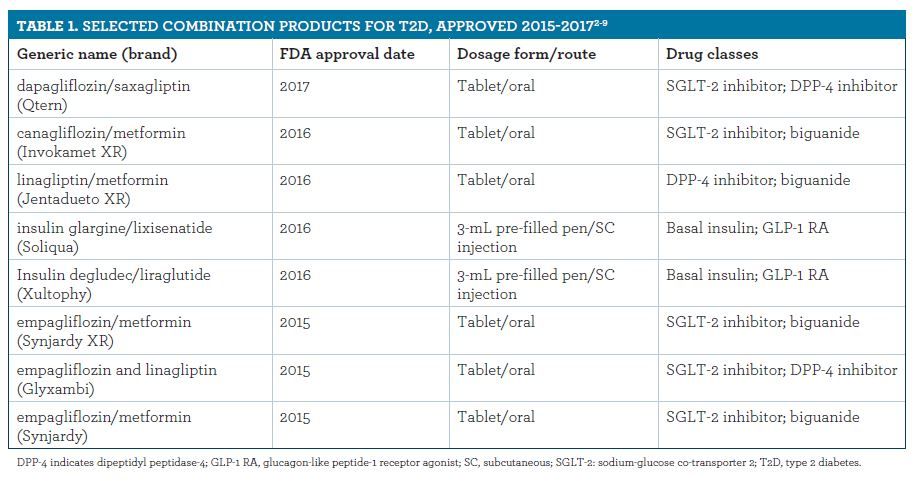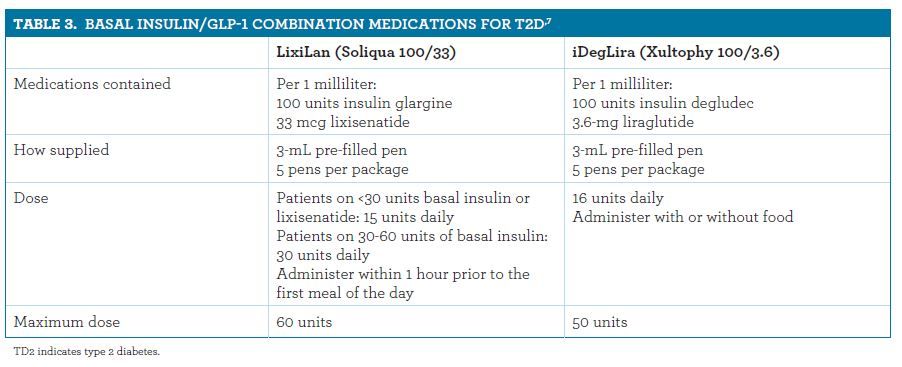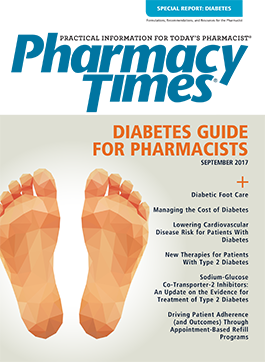New Therapies for Patients With Type 2 Diabetes
Many patients with T2D will require insulin therapy; however, these patients are also likely to develop insulin resistance over time.
Diabetes mellitus is a growing health problem in the United States. According to a recent CDC report, as of 2015, 30.3 million Americans (9.4% of the US population) have diabetes. Of these, 90% to 95% are diagnosed with type 2 diabetes (T2D). This number will likely continue to grow, because an estimated 84.1 million Americans have pre-diabetes, putting them at increased risk of T2D development.1 The manufacturers of the novel combination therapies that enter the market each year hope to simplify medication regimens for patients with T2D and to improve their adherence. Select combination products that were approved in the last few years for T2D are listed in Table 1.2-9

Many patients with T2D will require insulin therapy; however, these patients are also likely to develop insulin resistance over time. Due to insulin resistance and decreased endogenous insulin secretion, patients may require higher insulin doses and an increased number of insulin injections.10 As the needed insulin dosage increases, so, typically, does the volume of injected insulin. Because larger volumes of insulin can lead to painful injections and unpredictable insulin absorption,10 concentrated insulins have become more prominent in clinical practice. Several different insulin formulations have become available in the last few years. Two new insulin/glucagon-like peptide-1 receptor agonist (GLP-1 RA) combination products have also recently entered the market.
INSULIN
Four different concentrated insulins are currently indicated for patients with T2D. These concentrated insulins are available in the pen formulation, apart from Humulin R U-500, which is also available in the vial formulation (Table 211-16). Each pen delivers the desired insulin dose in a smaller volume, which negates the need for dose conversions. For example, if a patient is instructed to inject 15 units of concentrated insulin, they should be advised to dial the pen to 15 units.

Humulin R U-500 in the vial formulation has been available since the 1950s. The U-500 regular insulin is 5 times more concentrated than insulin U-100. To avoid the risk of a dose conversion error for patients taking insulin U-500, many health care practices dispensed tuberculin syringes instead of insulin U-100 syringes; patients were at risk for administering the incorrect dosage.17 As a solution, a dedicated syringe for the administration of Humulin R U-500 insulin was approved by the FDA in July 2016; currently, this is the only device approved for use with a U-500 insulin vial.18 The U-500 insulin syringe is available by prescription only.
In 2016, Humulin R U-500 KwikPen was approved for patients with diabetes who inject more than 200 units of insulin per day.19 Each pen holds 1500 units, dials in 5-unit increments, and does not need dose conversions.19 The U-500 KwikPen comes in a distinctive aqua color and up to 300 units can be injected at a time. Humulin R U-500 has a longer duration of action than regular insulin U-100, and it may be used without basal insulin.10 Improvements in glycemic control have been observed when patients made the switch from U-100 insulin products to U-500 regular insulin.10,19,20 Although the risk for hypoglycemia does not appear to increase after switching from U-100 to U-500 insulin; an increase in mild hypoglycemic events as well as an increase in weight gain and total daily insulin dose have been reported.20 An algorithm for switching patients from insulin U-100 to Humulin R U-500 has been proposed in literature; however, definitive dosing adjustment guidelines for this do not currently exist.20
Insulin lispro U-200 (Humalog) was approved in 2015 and is 2 times more concentrated than insulin U-100. It is the only concentrated bolus insulin available. It is considered to be bioequivalent to lispro U-100 and provides similar rates of glycemic control and hypoglycemia.17 Dose conversion is not needed when switching between the formulations. 12 Insulin lispro U-200 contains more units of insulin per pen (Table 211-16) and is a good option for patients who require high mealtime doses of insulin or use a large number of bolus insulin pens each month.
Two concentrated basal insulin formulations also approved in 2015 include insulin glargine U-300 (Toujeo) and insulin degludec U-200 (Tresiba). Insulin glargine U-300 is 3 times more concentrated than U-100 insulin, while insulin degludec U-200 is 2 times more concentrated than insulin U-100. When making the switch from once-daily Lantus to Toujeo, the same starting insulin dose can be used.14,16 However, patients controlled on Lantus may need a higher daily dose of Toujeo to maintain the same level of glycemic control.14 Therefore, frequent blood sugar monitoring should be encouraged to make appropriate insulin adjustments. When switching from long-acting or intermediate-acting insulins, the same total daily dose of insulin degludec can be used.11 Compared with Lantus, Toujeo and Tresiba provide similar glycemic control to Lantus and they have a duration of more than 24 hours.17,21-24 Both products also have a lower risk of nocturnal hypoglycemia than does Lantus with Toujeo providing less overall hypoglycemia and less weight gain than Lantus.22-24 Toujeo is available in a 1.5-mL pen, which contains 450 units of insulin.14 Both Tresiba U-100 and U-200 are available in 3-mL pen formulations.11 Although Tresiba U-100 contains 300 units of insulin and can deliver up to 80 units of insulin per dose, Tresiba U-200 contains 600 units and can deliver up to 160 units of insulin per dose (Table 211-15).11 Therefore, Tresiba U-200 is a good option for patients who are injecting large doses of insulin.
Ryzodeg 70/30, a combination of insulin degludec and insulin aspart in a 3-mL pre-filled pen, was approved around the same time as insulin degludec U-100 and U-200 in 2015. If patients administer Ryzodeg 70/30 on a once-daily schedule, then the dose should be taken with the main meal. If patients administer Ryzodeg 70/30 on a twice-daily schedule, then the doses should be taken with the 2 largest meals.25 Because insulin adjustment is more difficult with insulin mixes, Ryzodeg 70/30 may have a limited role in clinical practice.
In 2015, the FDA approved Basaglar, a new brand of long-acting insulin glargine. Basaglar cannot be automatically substituted for Lantus, and a new prescription should be obtained prior to making the switch. Compared with Lantus in patients with T2D, Basaglar was comparable in glycemic control and rate of adverse reactions.17,26 When making the switch from Lantus to Basaglar, the insulin dose can remain the same.26 Although Basaglar may not offer much clinical advantage over Lantus for patients with T2D, it may be a cheaper treatment option.
GLP-1 RECEPTOR AGONISTS
Lixisenatide (Adlyxin), a new GLP-1 RA, was approved in 2016. However, its use as a monotherapy may be limited, as there are already many medications in its class on the market. Lixisenatide may prove to be more useful when used in combination with another GLP-1 RA (see Soliqua, discussed below) in patients who are not controlled on basal insulin alone. As a monotherapy, lixisenatide is available in two 3-mL pre-filled pens: a 50 mcg/mL green pen (with 14 pre-set doses, 10 mcg per dose) and a 100 mcg/mL burgundy pen (with 14 pre-set doses, 20 mcg per dose).27 The starter pack contains an initiation pen and a maintenance pen, as lixisenatide should be initiated with 10 mcg administered as a subcutaneous injection once daily for 14 days, after which the dose should be increased to 20 mcg once daily.27
INSULIN/GLP-1 RECEPTOR AGONIST COMBINATION PRODUCTS
Combination products are beneficial for patients because they reduce the number of doses required for diabetes management. Combination products of basal insulin and GLP-1 receptor agonists were approved by the FDA in 2016.
IGlarLixi (Soliqua 100/33) contains 100 units of insulin glargine and 33 mcg of lixisenatide per milliliter.5 Soliqua 100/33 pen delivers doses from 15 to 60 units with each injection.5 Alternative therapy should be considered for patients who require a Soliqua 100/33 daily dose below 15 units or over 60 units.5
IDegLira (Xultophy 100/3.6) contains 100 units of insulin degludec and 3.6 mg of liraglutide per milliliter.7 Xultophy 100/3.6 pen delivers doses from 10 to 50 units with each injection.7 Alternative therapy should be considered for patients who require a Xultophy 100/3.6 daily dose below 16 or over 50 units.7 The dosing and timing of administration for Soliqua and Xultophy are listed in Table 3.5,7

Basal insulin plus GLP-1 RAs are associated with less hypoglycemia and with weight loss as opposed to weight gain; however, they may be costly as they are not available in generic formulation.28 These medications were also found to be more likely to achieve glycemic control when used in combination versus alone.29,30 Some studies have even shown that these combination products have fewer gastrointestinal adverse effects than using GLP-1 RAs alone.17,30 Xultophy 100/3.6 carries a black box warning of risk of thyroid C-cell tumors in rats and mice.7 Soliqua and Adlyxin do not have this warning.
INHALED INSULIN
In 2014, the FDA approved Afrezza, a rapid-acting inhaled insulin administered prior to meals. Compared with insulin aspart, Afrezza has a lower risk of postprandial hypoglycemia and weight gain.17 Common adverse effects include cough and throat pain or irritation.31 It has a black box warning that the risk for acute bronchospasm has been observed in patients with asthma or chronic obstructive pulmonary disease (COPD). Therefore, Afrezza should not be used in patients with chronic lung disease, such as asthma or COPD.31 Before initiating Afrezza, providers should perform a detailed exam (including pulmonary function test) to rule out any potential lung disease.31 Afrezza should not be recommended to patients who smoke or have recently quit smoking (<6 months).31 Furthermore, because long-term pulmonary safety data are lacking, many clinicians may be apprehensive to recommend this insulin to patients.17 Afrezza offers a unique route of administration and may be a good option for patients who do not like to inject insulin. It is supplied in color-coded single-use cartridges of 4, 8, or 12 units; they should be refrigerated if not in use.31 In 2007, Exubera, a rapid-acting inhaled insulin, experienced low sales and was removed from the market after just 1 year. Whether Afrezza will have the same fate remains to be seen.
CONCLUSION
As diabetes prevalence increases, more novel and combination products for diabetes management will become available. Providers should counsel patients on lifestyle changes and deliver patient-centered medication therapy for diabetes management. When choosing the most optimal diabetes therapy, the dosage form, risk of hypoglycemia, cost, and potential adverse events should be taken into consideration for each patient.
JELENA LEWIS, PHARMD, is an assistant professor of pharmacy practice at Chapman University School of Pharmacy, Irvine, California, and faculty in residence at St. Jude Heritage Medical Group, Fullerton, California.
REFERENCES
- National Diabetes Statistics Report, 2017. CDC website. cdc.gov/diabetes/pdfs/ data/statistics/national-diabetes-statistics-report.pdf. Published 2017. Accessed August 14, 2017.
- Qtern [prescribing information]. Wilmington, DE: AstraZeneca Pharmaceuticals LP; 2017.
- Invokamet XR [prescribing information]. Titusville, NJ: Janssen Pharmaceuticals, Inc; 2016.
- Jentadueto XR [prescribing information]. Ridgefield, CT: Boehringer Ingelheim Pharmaceuticals, Inc; 2016.
- Soliqua 100/33 (insulin glargine and lixisenatide injection) [prescribing information]. Bridgewater, NJ: Sanofi; 2016.
- Synjardy XR [prescribing information] Ridgefield, CT: Boehringer Ingelheim Pharmaceuticals, Inc; 2016.
- Xultophy 100/3.6 (insulin degludec and liraglutide injection) [prescribing information]. Plainsboro, NJ: Novo Nordisk; 2016.
- Glyxambi [prescribing information]. Ridgefield, CT: Boehringer Ingelheim Pharmaceuticals, Inc; 2017.
- Synjardy [prescribing information]. Ridgefield, CT: Boehringer Ingelheim Pharmaceuticals, Inc; 2016.
- Lamos EM, Younk LM, Davis SN. Concentrated insulins: the new basal insulins. Ther Clin Risk Manag. 2016;12:389-400. doi: 10.2147/TCRM.S99855.
- Tresiba (insulin degludec injection) [prescribing information]. Plainsboro, NJ: Novo Nordisk; 2016.
- Humalog (insulin lispro injection) [prescribing information]. Indianapolis, IN: Lilly; 2015.
- Lantus (insulin glargine injection) [prescribing information]. Bridgewater, NJ: Sanofi-Aventis; 2015.
- Toujeo (insulin glargine injection) [prescribing information]. Bridgewater, NJ: Sanofi; 2015.
- Lantus SoloSTAR (insulin glargine injection) [SoloSTAR guide]. Bridgewater, NJ: Sanofi; 2015.
- Toujeo SoloSTAR (insulin glargine injection) [HCP communication sheet]. Bridgewater, NJ: Sanofi; 2015.
- American Pharmacists Association. Beyond oral antidiabetics: insulin therapy options and combinations. Pharm Today. 2017;23(6):53-65. doi: 10.1016/j. ptdy.2017.05.030.
- FDA approves a dedicated syringe to be used with humulin R U-500 insulin. FDA website. fda.gov/Drugs/DrugSafety/ucm510318.htm. Published July 8, 2016. Accessed August 14, 2017.
- Humulin R U-500 [prescribing information]. Indianapolis, IN: Lilly; 2016.
- Church TJ, Haines ST. Treatment approach to patients with severe insulin resistance. Clin Diabetes. 2016;34(2):97-104. doi: 10.2337/diaclin.34.2.97.
- Becker RH, Dahmen R, Bergmann K, Lehmann A, Jax T, Heise T. New insulin glargine 300 units-mL-1 provides a more even activity profile and prolonged glycemic control at steady state compared with insulin glargine 100 units-mL-1. Diabetes Care. 2015;38(4):637-643. doi: 10.2337/dc14-0006.
- Ritzel R, Roussel R, Bolli GB, et al. Patient-level meta-analysis of the EDITION 1, 2 and 3 studies: glycaemic control and hypoglycaemia with new insulin glargine 300 U/ml versus glargine 100 U/ml in people with type 2 diabetes. Diabetes Obes Metab. 2015;17(9):859-867. doi: 10.1111/dom.12485.
- Rodbard HW, Cariou B, Zinman B, et al; BEGIN Once Long trial investigators. Comparison of insulin degludec with insulin glargine in insulin-naive subjects with type 2 diabetes: a 2-year randomized, treat-to-target trial. Diabet Med. 2013;30(11):1298-1304. doi: 10.1111/dme.12303.
- Ratner RE, Gough SC, Mathieu C, et al. Hypoglycaemia risk with insulin degludec compared with insulin glargine in type 2 and type 1 diabetes: a preplanned meta-analysis of phase 3 trials. Diabetes Obes Metab. 2013;15(2):175- 184. doi: 10.1111/dom.12032.
- Ryzodeg 70/30 (insulin degludec and insulin aspart injection) [prescribing information]. Plainsboro, NJ: Novo Nordisk; 2015.
- Basaglar (insulin glargine injection) [prescribing information]. Indianapolis, IN: Lilly; 2016.
- Adlyxin (lixisenatide) [prescribing information]. Bridgewater, NJ: Sanofi; 2016.
- American Diabetes Association. Standards of medical care in diabetes 2017. Diabet Care. 2017;40(suppl 1):S1-S135.
- Gough SC, Bode B, Woo V, et al; NN9068-3697 (DUAL-I) trial investigators. Efficacy and safety of a fixed-ratio combination of insulin degludec and liraglutide (IDegLira) compared with its components given alone: results of a phase 3, open-label, randomised, 26-week, treat-to-target trial in insulin-naive patients with type 2 diabetes. Lancet Diabetes Endocrinol. 2014;2(11):885-893. doi: 10.1016/S2213-8587(14)70174-3.
- Rosenstock J, Aronson R, Grunberger G, et al; LixiLan-O Trial Investigators. Benefits of lixiLan, a titratable fixed-ratio combination of insulin glargine plus lixisenatide, versus insulin glargine and lixisenatide monocomponents in type 2 diabetes inadequately controlled on oral agents: the LixiLan-O randomized trial. Diabetes Care. 2016;39(11):2026-2035.
- Afrezza (insulin human) inhalation powder [prescribing information]. Danbury, CT: MannKind Corp; 2017.

